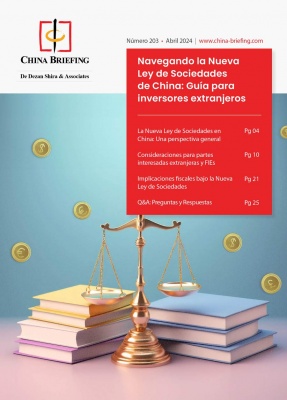The Balanced Flavors of Success in China’s Food & Beverage Industry
 By Mary Field
By Mary Field
After another food safety scandal rocked American fast-food giant McDonalds in July, the company announced that it will be stepping up the number of audits it performs on its Chinese suppliers. Today, foreign brands are increasingly wary of approaching China’s volatile yet hugely lucrative market, even as Chinese consumers remain hungry for the perceived quality, and more importantly, safety, of imported goods.
This is reflected in the sheer number of international food companies in the country, for whose products Chinese consumers are willing to pay a premium. Getting foreign food and beverages onto the tables of Chinese consumers requires an understanding of China’s import regulations, corporate establishment procedure and viable marketing strategies.
In 2009, American expat Steven Liang founded online grocery store FIELDS, focused on delivering fresh produce to consumers in Shanghai, Jiangsu and Zhejiang. Liang’s business reached an important milestone in 2012 when his customer base, previously made up primarily of expats, shifted to a Chinese majority. This, according to FIELDS vice president of sales and marketing Daisy Song, is crucial for long-term growth in China, where expats are a transient population, often moving to other cities or countries within a few years.
The case of FIELDS also illustrates the Chinese consumer’s willingness to pay a premium for imported foods, often with an organic or non-GMO label. According to the China National Bureau of Statistics, the prices at companies such as FIELDS for meat and produce can be two to six times higher than for local products. Ms. Song attributes this success to FIELDS’ focus on building “an ethical and transparent business” — a strategy that seems to be paying off against the backdrop of near constant food scares.
Xibarita, a Spanish gourmet shop and wine bar adopted a more bricks-and-mortar approach, setting up shop in Shanghai’s Sinan Sansions and specializing in a relatively narrow range of products. According to Sales Executive Borja Iñiguez, the company distributes 16 product lines, imported exclusively from Spain. The company hopes that having one of the largest portfolios of fine wine in China will attract consumers in one of the world’s thirstiest wine markets.
RELATED: Industry Focus: Importing Wine into China
These success stories belie the considerable regulatory and marketing hurdles needing to be overcome before reaching the Chinese consumer. Companies seeking greater control over their sales and marketing in China should consider opening up a foreign invested commercial enterprise (FICE)—essentially a trading company. Only a FICE whose business scope includes retail operations, however, may set up a physical shop, like Xibarita’s location in Shanghai. In addition to typical considerations such as foot traffic, foreign investors should remember that shops in China must be established in commercially zoned locations.
Whether an international food producer decides to set up their own FICE in China or work with an in-country distributor, there are several other regulatory considerations for importing food products into China. These include: Customs, import licenses (especially for meat, dairy, fish and other aquatic products), tariff rates, rules of origin, food safety and biosecurity requirements, and labeling requirements.
Beyond legal and regulatory requirements, localized marketing is essential to getting your products onto the tables of Chinese consumers. The global rise of digital marketing has provided companies the world over with inexpensive tools to reach new clients, and China is no exception. But the Asian giant’s “great firewall” and unique social media platforms ensure that any successful marketing strategy must have a distinctly Chinese flavor.
RELATED: Entering the Chinese Food & Beverage Market – The San Gines Way
Conventional wisdom dictates that consumers will always need to smell and taste new food products – especially foreign ones –, something that can only be done in the offline world. In China, this has historically meant hiring demonstrators and promoters, often dressed in branded uniforms, to hand out product samples at supermarkets. Despite its questionable ROI and overall effectiveness, this has long been the conventional marketing strategy for foreign (and domestic) brands entering the Chinese market. But rising labor costs, plus the costs of setting up supermarket displays and giving away free products, have made digital marketing an increasingly attractive option.
Digital marketing and social media are now being used to support more conventional methods and to create additional channels through which consumers can interact with brands. While currently, Xibarita’s products can only be purchased at their physical storefront, Iñiguez is confident of the growing role that online activities will play in the future of the company. “We are [already] very active on Wechat, offering our followers all kinds of information about our products and Spanish culture, as well as keeping them updated on our coming events, promotions, lucky draws, etc.”
RELATED: Trends in China’s E-Commerce Market
FIELDS, meanwhile, pursued an online-only strategy to avoid China’s high real estate costs. According to Ms. Song, in first-tier cities such as Shanghai, a business like FIELDS “can’t invest in things like refrigeration if you are spending too much on rent.” Branching out from their website, the company has rolled out several mobile apps over the past year, in which growth has been “very fast.” As an online business reliant on internet searches and social media to retain and bring in new customers, FIELDS maintains a team dedicated to providing content for these platforms.
In addition to social media, most international brands have a Chinese-language version of their website. Simply translating one’s website into Chinese is only part of what’s needed to appeal to Chinese consumers. Professor Katharina Reinecke of the University of Michigan has done extensive research on quantifying the visual preferences of different nationalities. Out of a sample of 42 countries, her research shows that the Chinese prefer more colorful and visually complex websites. For Western brands trying to break into the Chinese market, it would be wise to tailor one’s website appropriately.
While many international companies have been enticed by the gradual relaxation of restrictions on foreign investment approval, setting up a company in China is still a complicated process. Those who attempt to set up their business without engaging a China-based consultant can face considerable problems down the road. Yet for all these challenges, a tantalizing and rapid-growth market awaits companies that can successfully navigate China’s regulatory and marketing landscapes. Foreign brands like FIELDS and Xibarita have demonstrated that, with the right recipe, success in China is a very real possibility.
Asia Briefing Ltd. is a subsidiary of Dezan Shira & Associates. Dezan Shira is a specialist foreign direct investment practice, providing corporate establishment, business advisory, tax advisory and compliance, accounting, payroll, due diligence and financial review services to multinationals investing in China, Hong Kong, India, Vietnam, Singapore and the rest of ASEAN. For further information, please email china@dezshira.com or visit www.dezshira.com.
Stay up to date with the latest business and investment trends in Asia by subscribing to our complimentary update service featuring news, commentary and regulatory insight.
Related Reading
 Industry Specific Licenses and Certifications in China
Industry Specific Licenses and Certifications in China
In this issue of China Briefing, we provide an overview of the licensing schemes for industrial products; food production, distribution and catering services; and advertising. We also introduce two important types of certification in China: the CCC and the China Energy Label (CEL). This issue will provide you with an understanding of the requirements for selling your products or services in China.
 China Retail Industry Report 2014
China Retail Industry Report 2014
In this special edition of China Briefing, we provide an overview of the retail industry in China and the procedures for setting up a retail shop, focusing specifically on brick-and-mortar physical retail stores. Further, we have invited our partner Direct HR to offer some insights on the talent landscape in the retail industry, as well as tips for recruiting retail personnel in China.
 Adapting Your China WFOE to Service China’s Consumers
Adapting Your China WFOE to Service China’s Consumers
In this issue of China Briefing Magazine, we look at the challenges posed to manufacturers amidst China’s rising labor costs and stricter environmental regulations. Manufacturing WFOEs in China should adapt by expanding their business scope to include distribution and determine suitable supply chain solutions. In this regard, we will take a look at the opportunities in China’s domestic consumer market and forecast the sectors that are set to boom in the coming years.
- Previous Article Golden Years: The Coming Investment Boom in China’s Elderly Care Industry
- Next Article Moving Shop: Changing the Registered Address of a Business in China (Part 1)
























